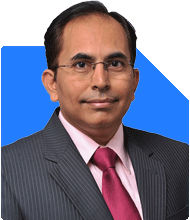Retiring Soon: How Much to Invest for Rs.1.5 Lakh Monthly SWP & Clearing Rs.50 Lakh Debt?
Ramalingam Kalirajan |10902 Answers |Ask -Follow
Mutual Funds, Financial Planning Expert - Answered on Aug 14, 2024
He has an MBA in finance from the University of Madras and is a certified financial planner.
He is the director and chief financial planner at Holistic Investment, a Chennai-based firm that offers financial planning and wealth management advice.... more

Hello sir I am planning to retire. How much corpus shud i put in to earn 1.5 lk / month is SWP. Also my husband has loans of 50 lks - personal , business and home and car loan. Whats the best way we can clear it. Shud we sell our car and gold as I want topreserve my corpus for post retirement.
Estimating the Corpus for Systematic Withdrawal Plan (SWP)
Income Requirement: You need Rs. 1.5 lakhs per month. This translates to Rs. 18 lakhs annually.
Withdrawal Rate: An SWP typically allows for a 4-5% annual withdrawal. This means you would need a significant corpus.
Corpus Calculation: To generate Rs. 18 lakhs annually, you may need a corpus of around Rs. 3.6 crores to Rs. 4.5 crores, depending on the withdrawal rate and the return on investment.
Tax Efficiency: SWPs from equity mutual funds are tax-efficient. The returns can be more tax-friendly compared to other investment options.
Diversification: Invest in a mix of equity and debt funds. This balances risk and provides a steady income stream.
Advantages of Actively Managed Funds Over Index Funds
Higher Potential Returns: Actively managed funds have the potential to outperform index funds. Fund managers actively select securities that can generate better returns.
Flexibility in Market Conditions: Fund managers can adapt to changing market conditions. This flexibility can lead to better performance in volatile markets.
Focus on Quality Stocks: Actively managed funds often focus on quality stocks with strong growth potential. This can enhance your returns over time.
Disadvantages of Index Funds: Index funds simply track a market index. They do not offer flexibility or the potential for higher returns. Also, during market downturns, index funds can see significant losses as they mirror the market's performance.
Professional Expertise: Investing through a Mutual Fund Distributor (MFD) with a Certified Financial Planner (CFP) credential ensures you receive expert guidance. They help in selecting the best funds suited to your risk profile and financial goals.
Managing Loans: Strategies for Efficient Repayment
Prioritise High-Interest Loans: Start by paying off high-interest loans first, such as personal or business loans. These typically have higher interest rates than home or car loans.
Utilise Surplus Funds: Any surplus funds, such as bonuses or dividends, should be directed towards loan repayment. This reduces your outstanding principal and lowers the interest burden.
Consider Partial Prepayments: If you have a lump sum, consider making partial prepayments. This can reduce the loan tenure and the total interest paid over time.
Debt Consolidation: If possible, consolidate your loans. This involves taking a single loan with a lower interest rate to pay off multiple high-interest loans. It simplifies repayment and may reduce your overall interest payments.
Maintain a Strict Budget: Stick to a strict budget to free up more funds for loan repayment. Cut unnecessary expenses and focus on clearing your debt.
Should You Sell Your Car and Gold?
Evaluating the Need: Selling your car and gold can provide immediate funds to repay loans. However, consider whether these assets are essential to your lifestyle or financial security.
Car Sale Consideration: If the car is not essential, selling it can free up funds. However, consider the depreciation and the resale value before making a decision.
Gold as an Investment: Gold is a valuable asset that can appreciate over time. Selling it should be a last resort. Instead, you can consider taking a gold loan, which might offer lower interest rates compared to other loans.
Preserving Your Corpus: It’s crucial to preserve your retirement corpus. Avoid using it to repay loans, as this could jeopardise your financial security post-retirement.
Creating a Comprehensive Financial Plan
Retirement Planning: Your retirement plan should ensure that your post-retirement income meets your expenses. Consider all potential sources of income, including pensions, SWPs, and other investments.
Debt-Free Retirement: Aim to enter retirement debt-free. Clearing your loans before retirement will reduce financial stress and help you maintain your desired lifestyle.
Emergency Fund: Maintain an emergency fund separate from your retirement corpus. This fund should cover 6-12 months of living expenses and any unforeseen expenses.
Regular Review: Review your financial plan regularly. Adjust your investments and loan repayment strategy as your financial situation changes.
Final Insights
Madam, planning for a comfortable retirement while managing loans requires a balanced approach. Prioritise clearing high-interest loans and preserving your retirement corpus. Consider selling non-essential assets only if necessary. A well-thought-out investment strategy, including SWPs, can provide a steady income while maintaining your financial security. Consulting with a Certified Financial Planner ensures that your plan is comprehensive and aligned with your goals.
Best Regards,
K. Ramalingam, MBA, CFP,
Chief Financial Planner,
www.holisticinvestment.in
You may like to see similar questions and answers below
Ramalingam Kalirajan |10902 Answers |Ask -Follow
Mutual Funds, Financial Planning Expert - Answered on May 11, 2024
Milind Vadjikar | Answer |Ask -Follow
Insurance, Stocks, MF, PF Expert - Answered on Oct 30, 2024
Ramalingam Kalirajan |10902 Answers |Ask -Follow
Mutual Funds, Financial Planning Expert - Answered on Jun 03, 2025
Reetika Sharma |429 Answers |Ask -Follow
Financial Planner, MF and Insurance Expert - Answered on Oct 11, 2025
Reetika Sharma |429 Answers |Ask -Follow
Financial Planner, MF and Insurance Expert - Answered on Oct 05, 2025
Anu Krishna |1749 Answers |Ask -Follow
Relationships Expert, Mind Coach - Answered on Dec 17, 2025
Anu Krishna |1749 Answers |Ask -Follow
Relationships Expert, Mind Coach - Answered on Dec 17, 2025
Radheshyam Zanwar |6748 Answers |Ask -Follow
MHT-CET, IIT-JEE, NEET-UG Expert - Answered on Dec 17, 2025
Anu Krishna |1749 Answers |Ask -Follow
Relationships Expert, Mind Coach - Answered on Dec 17, 2025
Dr Shakeeb Ahmed Khan |184 Answers |Ask -Follow
Physiotherapist - Answered on Dec 17, 2025
T S Khurana |538 Answers |Ask -Follow
Tax Expert - Answered on Dec 17, 2025
T S Khurana |538 Answers |Ask -Follow
Tax Expert - Answered on Dec 17, 2025
Janak Patel |72 Answers |Ask -Follow
MF, PF Expert - Answered on Dec 17, 2025
Ramalingam Kalirajan |10902 Answers |Ask -Follow
Mutual Funds, Financial Planning Expert - Answered on Dec 17, 2025
Samraat Jadhav |2511 Answers |Ask -Follow
Stock Market Expert - Answered on Dec 17, 2025












.jpg)
















